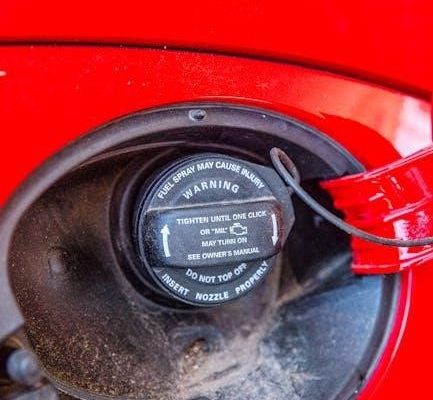Chainsaw Manual⁚ A Comprehensive Guide
This comprehensive guide covers all aspects of chainsaw operation, from selecting the right saw and understanding its components to mastering various cutting techniques and ensuring safe, responsible use․ We delve into safety regulations, maintenance procedures, and troubleshooting common problems․ Learn how to choose appropriate accessories and gear, and understand the environmental impact of chainsaw use․ Whether you’re a seasoned professional or a beginner, this manual provides essential knowledge for safe and effective chainsaw operation․ Mastering the art of chainsaw use requires diligent study and practice․
Choosing the Right Chainsaw
Selecting the appropriate chainsaw hinges on several key factors․ First, consider the intended applications․ For home use, a 14- to 18-inch bar length is often sufficient for tasks like pruning, trimming, and cutting firewood․ Larger bars are necessary for felling larger trees, demanding more power and potentially greater weight․ Assess your physical capabilities; a heavier saw requires more strength and stamina․ Engine size directly impacts cutting capacity and power; larger engines tackle thicker wood more efficiently․ Consider the type of cutting you’ll perform․ A homeowner might prioritize ease of use and maneuverability, while a professional logger needs durability and raw power․ Different chainsaws cater to various needs, from compact, lightweight models for pruning to robust, high-powered saws for felling large trees․ Budget plays a role; prices vary significantly based on features, power, and brand reputation․ Researching different models and reading reviews from other users can help you make an informed decision․ Remember to prioritize safety features like chain brakes and low-kickback chains․
Safety Precautions and Regulations
Operating a chainsaw demands strict adherence to safety regulations and precautions․ Always wear appropriate personal protective equipment (PPE), including safety glasses or a face shield, hearing protection, gloves, steel-toed boots, and chainsaw chaps․ Before starting any work, inspect the area for hazards like overhead obstructions, unstable ground, or hidden obstacles․ Plan your cuts carefully, avoiding cutting overhead or in the kickback zone․ Keep a firm grip on the chainsaw and maintain balanced footing․ Never operate a chainsaw while fatigued or under the influence of drugs or alcohol․ Regularly sharpen and maintain your saw chain to ensure optimal performance and reduce the risk of kickback․ Be aware of the surroundings and potential hazards; never operate a chainsaw near bystanders․ Understand the meaning of all safety symbols on the chainsaw and in the manual․ Refuel the chainsaw only in a well-ventilated area, away from open flames or sparks․ Proper maintenance and regular inspections are crucial for safe chainsaw operation․ Always follow local and national regulations concerning chainsaw use and forestry work․
Starting and Stopping the Chainsaw
Proper starting and stopping procedures are crucial for safe chainsaw operation․ Before starting, ensure the chain brake is engaged and the chainsaw is placed securely on a stable surface․ Familiarize yourself with the specific starting instructions provided in your chainsaw’s manual․ Generally, this involves setting the controls correctly, engaging the choke (if necessary), and pulling the starter cord with a firm, steady motion․ Once the engine starts, allow it to run for a few moments to stabilize before engaging the chain brake․ To stop the chainsaw, release the throttle and allow the engine to idle before turning it off using the stop switch․ Never attempt to stop the chain by engaging the brake while the chain is still running at full speed․ Always ensure the chain comes to a complete stop before setting the chainsaw down․ If the engine fails to start, check fuel levels, spark plugs, and other potential issues outlined in your manual’s troubleshooting section․ Improper starting or stopping techniques can lead to accidents or damage to the chainsaw․
Basic Cutting Techniques⁚ Pruning and Trimming
Pruning and trimming with a chainsaw requires precision and careful technique․ Before starting, assess the branch or limb to determine the best cutting strategy․ For smaller branches, a single cut might suffice, but larger limbs often require a two-cut process to prevent bark stripping and uncontrolled falling․ The first cut should be an undercut, a partial cut from the underside of the branch, leaving a small hinge․ This hinge provides control over the branch’s fall․ The second cut, the felling cut, is made above the undercut, severing the branch․ Always keep a safe distance from the falling limb, and never stand directly beneath it․ When working with larger branches or trees, consider using wedges to guide the fall and prevent binding․ For thicker branches, a three-cut process may be necessary, employing a directional cut to guide the fall․ Remember to always maintain a firm grip, using both hands on the chainsaw handles, and keep your body balanced․ Practice these techniques on smaller branches before tackling larger ones to build confidence and skill․
Advanced Cutting Techniques⁚ Felling Trees
Felling trees safely and efficiently demands advanced chainsaw skills and meticulous planning․ Begin by assessing the tree’s lean, height, and surrounding obstacles․ Clear the area around the tree of any obstructions to ensure a safe felling zone․ Determine the felling direction, considering the tree’s lean and the safest escape route․ Make the felling cut on the side of the tree facing the felling direction․ This cut should be slightly higher than the hinge cut to allow for a controlled fall․ The hinge is crucial for directing the tree’s fall and should be left intact until the final moments․ The back cut, also known as the felling cut, should be made opposite the felling cut․ This cut should be made at a slight upward angle to prevent the tree from binding on the hinge․ Avoid cutting all the way through, leaving a small hinge section to control the tree’s fall․ Once the tree starts to fall, immediately retreat along your pre-determined escape route․ Never attempt to fell a large tree without appropriate training and experience․ Incorrect felling techniques can lead to dangerous situations, so always prioritize safety․
Chainsaw Maintenance and Repair
Regular maintenance is crucial for ensuring your chainsaw’s longevity and safe operation․ After each use, clean the bar and chain thoroughly, removing sawdust and debris․ Lubricate the bar and chain with a high-quality bar and chain oil to prevent wear and tear․ Sharpen or replace the saw chain as needed; a dull chain reduces cutting efficiency and increases the risk of kickback․ Inspect the chain for any damage or wear and replace it if necessary․ Check the air filter regularly and clean or replace it if it’s clogged with debris; a dirty air filter can restrict airflow to the engine, reducing performance․ Inspect the spark plug and ensure it’s clean and properly gapped․ Regularly check the fuel and oil levels, making sure to use the correct fuel mixture․ Inspect all nuts, bolts, and screws, tightening any that are loose․ For more extensive repairs or if you’re uncomfortable performing maintenance tasks yourself, consult a qualified chainsaw technician․ Remember, proper maintenance significantly extends the life of your chainsaw and reduces the risk of accidents․
Troubleshooting Common Problems
If your chainsaw won’t start, check the fuel and oil levels, ensuring you’re using the correct fuel mixture․ Inspect the spark plug, cleaning or replacing it if necessary․ A clogged air filter can also prevent starting; clean or replace it as needed․ If the chainsaw starts but lacks power, check the air filter and chain sharpness․ A dull chain significantly reduces cutting performance․ If the chain is binding or not moving freely, check for proper tension and lubrication․ Excessive vibration could indicate loose parts or a damaged chain; inspect thoroughly and tighten or replace any faulty components․ If the chainsaw is overheating, ensure proper lubrication and avoid overloading the engine․ Listen for unusual noises; unusual sounds often indicate a problem that needs attention․ If the problem persists after checking these basic points, consult your owner’s manual or seek professional assistance․ Remember, attempting complex repairs without the proper knowledge could lead to further damage or injury․
Understanding Chainsaw Parts and Components
Familiarizing yourself with your chainsaw’s components is crucial for safe and effective operation․ The engine, the powerhouse of the saw, provides the necessary power for cutting․ The fuel tank stores the fuel mixture required for engine operation; always use the correct mixture ratio․ The oil tank holds the bar and chain oil, essential for lubrication and preventing overheating․ The chain brake is a critical safety feature, instantly stopping the chain in case of kickback․ The guide bar directs the chain’s movement, providing a stable cutting surface․ The saw chain, with its sharp teeth, performs the actual cutting․ The clutch engages and disengages the chain, allowing for safe starting and stopping․ The air filter cleans the air entering the engine, protecting it from debris․ The spark plug ignites the fuel mixture, starting the engine․ Understanding each part’s function and location allows for better maintenance, troubleshooting, and overall safe operation․ Regular inspection of these parts is essential for preventing accidents and ensuring optimal performance․ Always refer to your owner’s manual for detailed diagrams and explanations․
Recommended Accessories and Gear
Proper safety gear is paramount when operating a chainsaw․ Essential items include safety glasses or a face shield to protect your eyes from flying debris; these should be impact-resistant and meet safety standards․ Hearing protection, such as earplugs or earmuffs, is crucial to mitigate the loud noise generated by the chainsaw․ Chainsaw chaps or pants are specifically designed to protect your legs from chain contact; ensure they are appropriately sized and meet safety regulations․ Sturdy work gloves provide a better grip and protect your hands from cuts and abrasions․ Steel-toed boots offer protection for your feet from falling objects or accidental drops of the chainsaw․ Consider a helmet for added head protection, especially when working in areas with overhead hazards․ A well-maintained chainsaw chain, properly sharpened and tensioned, is also an essential accessory, ensuring efficient cutting and reducing the risk of kickback․ Remember, investing in quality safety gear is a crucial step in preventing injuries and ensuring safe operation․ Check your local regulations for specific requirements․
Environmental Considerations and Responsible Use
Operating a chainsaw responsibly involves minimizing its environmental impact․ Properly disposing of used bar and chain oil is crucial; never pour it down drains or onto the ground․ Check local regulations for appropriate disposal methods, often involving designated hazardous waste facilities․ Consider the impact on local wildlife; avoid unnecessary cutting and choose times that minimize disturbance to animals․ When felling trees, plan the cut carefully to avoid damaging surrounding vegetation and minimize soil erosion․ Properly managing wood waste is crucial; consider recycling or repurposing wood where possible, reducing landfill waste․ Using a chainsaw with low emission technology can also contribute to a smaller carbon footprint․ Regular maintenance of your chainsaw, ensuring optimal performance, reduces fuel consumption and emissions․ Be aware of noise pollution and try to minimize noise disturbance to nearby residents․ Responsible chainsaw use involves a commitment to environmental stewardship, ensuring the long-term health of forests and ecosystems․ Always adhere to local regulations and best practices for sustainable forestry․

